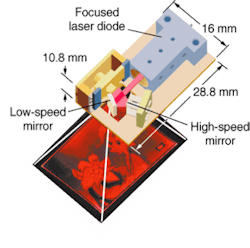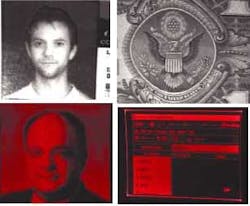Although cell phones and other small mobile devices can pack a lot of usefulness into a small package, miniaturization does nothing good for the visibility of their displays. One well-known way around this problem is to combine a microdisplay with viewing optics—a solution that works well for one user, but not for two or more. Engineers at Symbol Technologies (Holtsville, NY) have developed another approach in which a laser projector is shrunk in size so that it becomes part of the mobile device. The device can then cast images onto a wall or held above a desk to project an image downward. A camera can also be integrated into the device to turn it into an all-purpose image manipulator.
The prototype projector unit itself is 28.8 × 16 × 10.8 mm in size (see Fig. 1). The volume of a production device might be 30% to 50% smaller, says Mik Stern, senior director of research and development at Symbol Technologies. The laser wavelength is 635 nm in the prototypes, but will be changed to 650 nm for production units to take advantage of the lower-cost lasers used in read/write DVD players, says Stern.
The laser is modulated and scanned in a raster pattern to produce an image, enabling the projection of photographic or full-motion video images (see Fig. 2). The image, which has a 640 × 480-pixel resolution and 16 gray levels, is always in focus and can be projected onto any diffuse surface. The power consumption of the projector is an average of 150 mW, or about the same as a reflective liquid-crystal display (LCD).
"Another interesting application [beyond cell phones] is a miniature projection display for the mobile professional," says Stern. "In many cases, salesmen wish to share some information with a couple of people, and a portable LCD projector is not always easily available. A pocket portable display accessory can be readily attached to a laptop or to a PDA, making it easy to show slides as well as motion video."
The projector is a class-2 laser device, making it safer than laser pointers, which are class-3a devices. Full-color versions of the projector are being considered, with cost and size of a practical device dependent on development of less-expensive blue-emitting laser diodes and the creation of a small- and cheap-enough frequency-doubled Nd:YAG laser.


